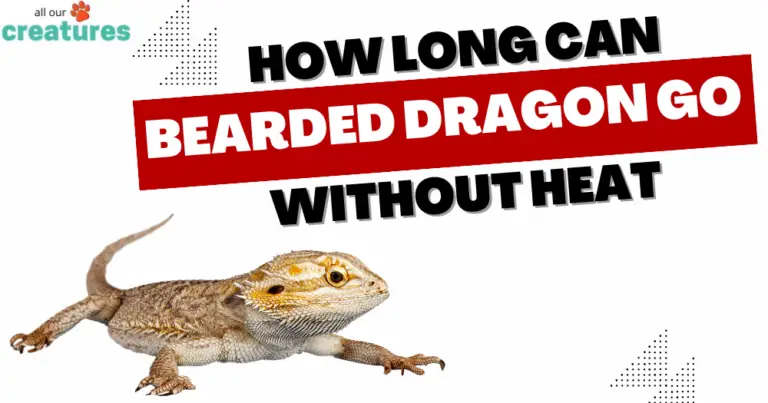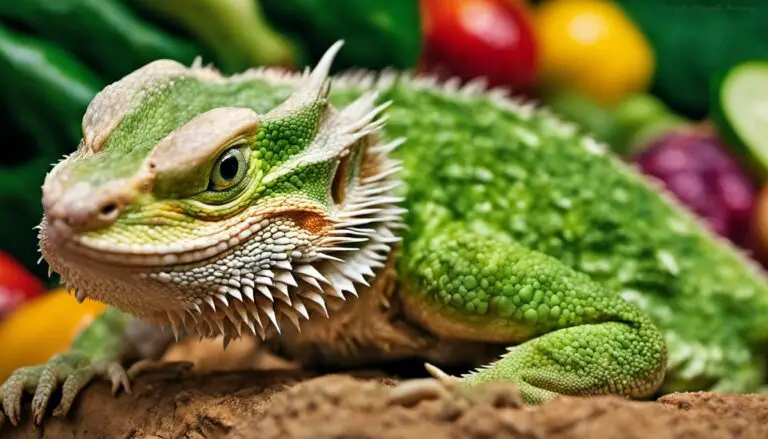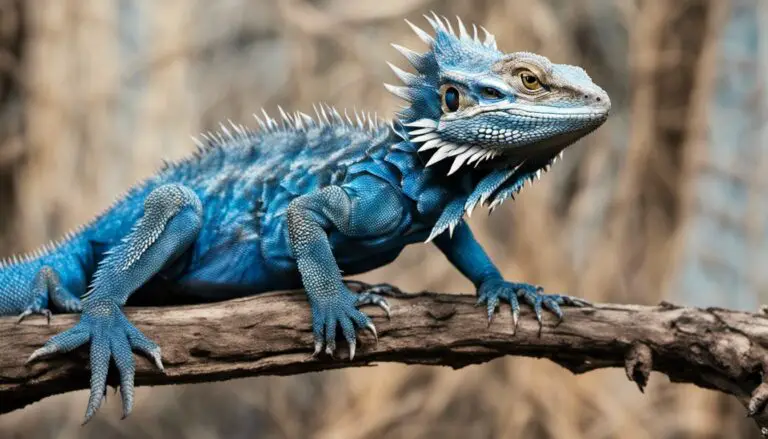How Big Do Bearded Dragons Get: A Comprehensive Guide to Their Growth
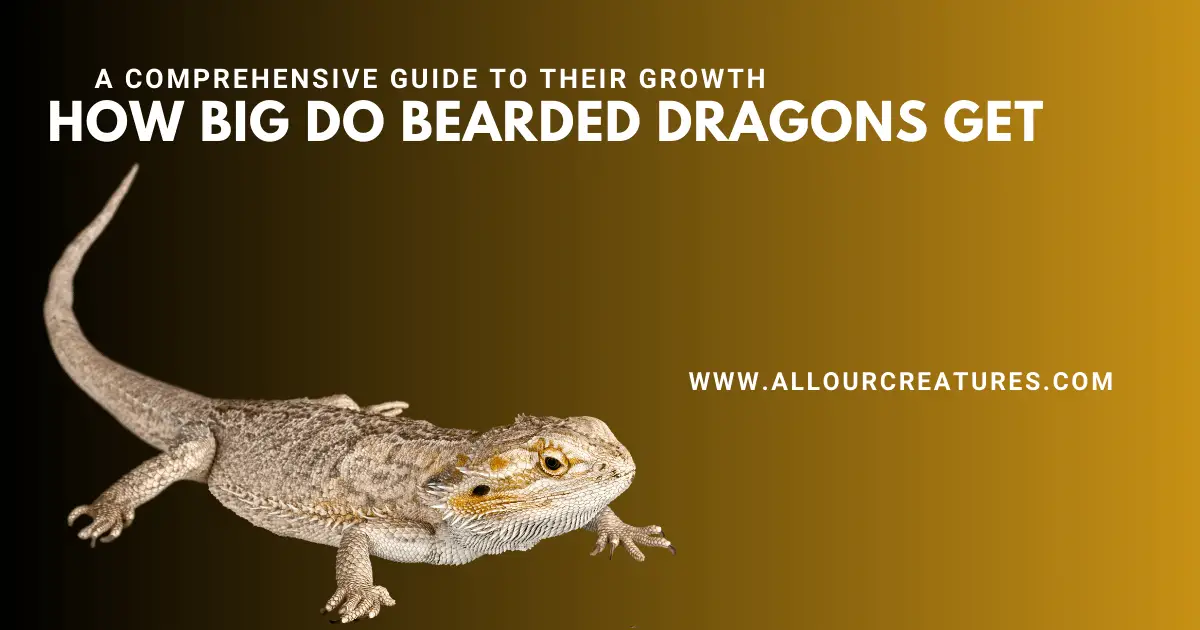
Bearded dragons are fascinating reptiles that have become increasingly popular as pets for their docile nature and unique appearance. These lizards, known scientifically as Pogona, are native to Australia and belong to the family Agamidae.
One of the most important aspects to consider when deciding to adopt a bearded dragon as a pet is understanding its growth and final size, as this can impact the required housing and overall care. How big do bearded dragons get? Let’s find out!
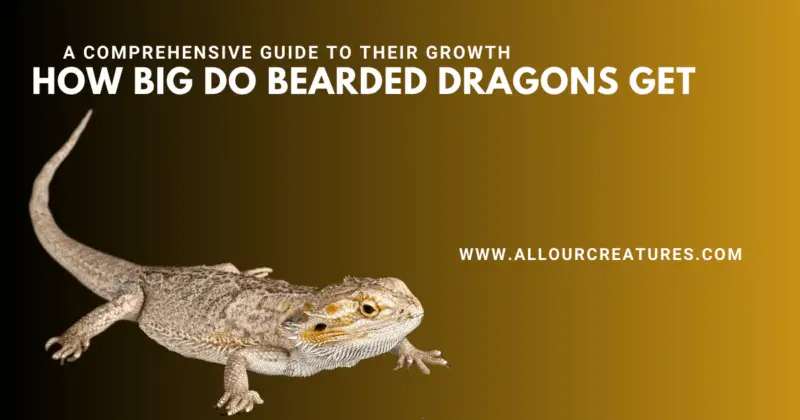
Contents
Table of Contents
How Big Do Bearded Dragons Get? Explained
How big do bearded dragons get? Typically, bearded dragons can range from 12 to 24 inches in length when fully grown, with the tail making up a significant portion of that measurement. Males generally grow larger than females, reaching 20 to 24 inches, while females typically measure between 16 to 20 inches.
Most bearded dragons are considered fully grown at around 11 to 12 months of age, although they may continue growing slightly and reach their adult weight of 230 to 520 grams within 18 to 24 months. As these lizards vary in size, it’s essential for potential owners to plan for appropriate housing that can accommodate their pet’s growth.
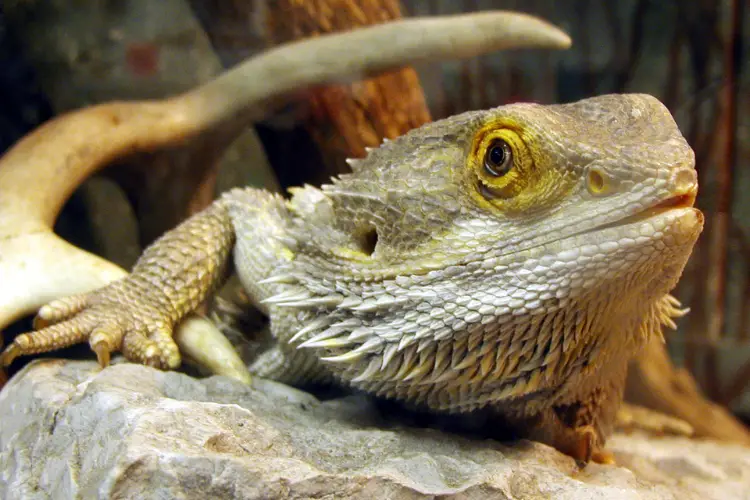
Understanding a bearded dragon’s growth and size is just one step in providing adequate care for these compelling creatures. Ensuring a proper diet, habitat, and socialization are also crucial components for maintaining their well-being. By being well-informed about the needs and growth patterns of bearded dragons, owners can ensure a healthy, happy life for their scaly companions.
Bearded Dragon Growth Fundamentals
Species Overview
Bearded dragons, scientifically known as Pogona, are a genus of reptiles native to Australia. There are several species and subspecies within this genus, including:
- Pogona vitticeps: Central Bearded Dragon
- Pogona barbata: Eastern Bearded Dragon
- Pogona minor mitchelli: Mitchell’s Bearded Dragon
- Pogona microlepidota: Drysdale River Bearded Dragon
- Pogona minor minima: Nullarbor Bearded Dragon
- Pogona henrylawsoni: Dwarf Bearded Dragon
Despite differences in their native habitats and appearance, the growth fundamentals for each species are generally similar.
Growth Stages
Bearded dragons follow a consistent growth pattern, from hatchlings to juveniles and then adults. Here’s a brief overview of their growth stages:
- Hatchlings: Bearded dragon hatchlings are small and delicate, measuring just a few inches in length. They grow quickly within the first few months of their lives, sometimes reaching lengths of 11 inches.
- Juveniles: In their first year, bearded dragons are considered juveniles. They continue to grow rapidly during this stage, reaching lengths of 15 to 18 inches. Some may grow an additional few inches in their second year.
- Adults: A fully grown bearded dragon will typically measure 16 to 24 inches in length and weigh between 300 and 550 grams. Bearded dragons achieve their full adult size around 18 months old. Male bearded dragons usually become larger than females.
Growth rates may vary depending on factors such as genetics, diet, living conditions, and overall health. It’s important to provide a suitable and nurturing environment to ensure the steady and healthy growth of your bearded dragon.
Remember that each bearded dragon species may vary slightly in terms of its size and growth rates; however, these growth fundamentals serve as a general guide applicable to the majority of the species within the Pogona genus.
Factors Affecting Bearded Dragon Size

In this section, we’ll discuss various factors that can impact the size of bearded dragons, such as genetics, diet, environment, and health conditions.
Genetics
Genetics play a crucial role in determining the size of a bearded dragon. As these reptiles grow, their genes determine factors such as their overall size, tail length, and weight. Bearded dragons can grow to be between 15 to 24 inches long, with males generally being larger than females.
Diet
A proper diet is essential for bearded dragons to maintain a healthy weight and achieve their full size potential. The right balance of nutrients, including calcium, helps in preventing health issues like metabolic bone disease. Bearded dragons should be fed a combination of insects, vegetables, and fruits to provide all essential nutrients.
Feed your bearded dragons:
- Calcium-rich vegetables like collard greens, dandelion greens, and kale
- Insects, such as crickets and dubia roaches
- Occasional treats of fruits like apples, berries, and melons
Environment
The environment in which a bearded dragon is raised plays a significant role in their growth and size. Factors such as temperature, humidity, and living space can impact their growth rate and overall health. Bearded dragons need to be housed in large tanks with dimensions that offer ample space for movement and temperature regulation, such as 48″ x 18″ x 21″.
Key factors to keep in mind for their environment include:
- Maintain a basking spot with temperatures between 95 and 100 degrees Fahrenheit
- Keep the humidity level between 30% and 40%
- Provide climbing opportunities, such as branches or rocks
Health Conditions
The health of a bearded dragon can significantly impact their size and weight. Underweight or overweight dragons may face health issues that can hinder their growth. Regular vet checkups, especially during their first year, are crucial in monitoring their growth and ensuring proper nourishment.
Some health conditions that can affect bearded dragon’s size:
- Metabolic Bone Disease: Caused by calcium deficiency, leading to weak bones and stunted growth
- Dehydration: Can cause weight loss and impact overall health
- Parasites: Can result in weight loss and decreased growth rate
By properly addressing these factors – genetics, diet, environment, and health conditions – you can ensure your bearded dragon grows and develops into a healthy, full-size reptile.
Measurement and Charts

How to Measure
To accurately measure your bearded dragon, start from the tip of its nose and extend the measuring tape or ruler to the tip of its tail. Be gentle and patient, allowing the bearded dragon to remain relaxed during the process. It’s also helpful to measure them while they are on a flat surface to ensure accurate measurements.
Growth Chart
Below is a general growth chart for bearded dragons, showcasing average size at different stages of their life:
| Age | Size (in inches) |
|---|---|
| 0-2 months | 3-11 |
| 3-4 months | 8-16 |
| 5-6 months | 11-18 |
| 7-8 months | 13-20 |
| 9-12 months | 16-22 |
| 18 months+ | 16-24 |
Keep in mind that individual growth rates may vary, and regular vet checkups are essential to ensure your bearded dragon is healthy and growing as it should.
Size Comparison by Species
Different species of bearded dragons can have varying sizes. Here are some averages for a few common species:
- Central Bearded Dragons: These typically have a more rounded body shape and reach up to 24 inches long, with an average adult size of 18-20 inches.
- Eastern Bearded Dragons: These are generally smaller, growing to 14-18 inches in length as adults.
It’s essential to know which species you have to anticipate their full-grown size accurately. Remember, size is not the only difference between species; they can also vary in temperament, coloration, and other aspects.
Feeding Guidelines for Optimal Growth
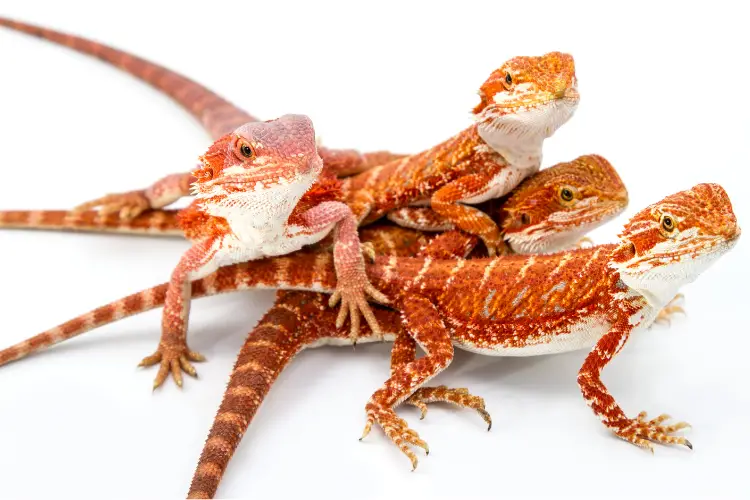
Protein Sources
Bearded dragons require a balanced diet that includes both protein and plant-based sources. For young dragons, protein is a crucial aspect of their diet to support their growth. Insects, such as crickets, mealworms, and dubia roaches, are excellent protein sources for bearded dragons. It is essential to provide your bearded dragon with as many insects as they can eat within a 10-15 minute time frame once per day for adults, which helps to prevent overfeeding or obesity.
- Calcium supplement: For young bearded dragons, it is recommended to provide a calcium supplement every other day for six months to one year. For dragons over the age of one, calcium should be given every two to three days or twice a week.
- Vitamin supplement: Vitamins are also essential for a bearded dragon’s growth. Young dragons should receive vitamin supplements three times per week, while adult dragons should get their vitamins every other day.
Fruits and Vegetables
Aside from proteins, bearded dragons also benefit from consuming fruits and vegetables as part of their balanced diet. It is essential to choose the right fruits and veggies, as some can be harmful to your pet. Some suitable fruits and vegetables for bearded dragons include:
| Fruits | Vegetables |
|---|---|
| Apples | Collard greens |
| Blueberries | Mustard greens |
| Strawberries | Dandelion greens |
| Raspberries | Bell peppers |
| Banana | Squash |
When feeding fruits, make sure to remove any seeds, as they can cause digestive issues. It is also essential to wash and cut the fruits and vegetables into small pieces to make it easier for your bearded dragon to consume them. Fruits should make up a smaller portion of the diet compared to vegetables, as they contain higher sugar content.
By following these feeding guidelines and providing a balanced diet, your bearded dragon can grow healthily and reach its optimal size of 15 to 24 inches by 18 months of age. Regular veterinary checkups during the first year are vital to ensure your bearded dragon is well-nourished and growing as expected.
Proper Housing for Bearded Dragons
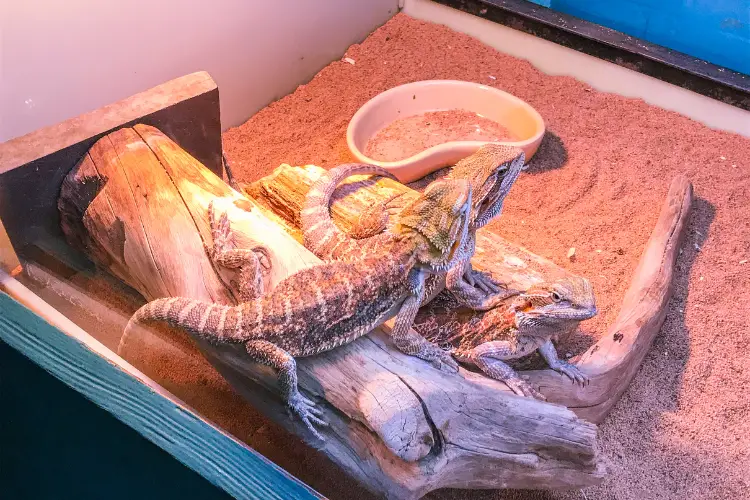
Enclosure Size
When selecting an enclosure for your bearded dragon, it’s important to consider their size and age. Adult bearded dragons usually reach 1 to 2 feet in length and can weigh up to 1 pound. For a fully-grown bearded dragon, an ideal enclosure size is a 125-gallon tank, measuring 72 inches long, 18 inches wide, and 16 inches tall.
However, juveniles can start with a 20-gallon aquarium, and as they grow, upgrade to a 60 or 100-gallon tank. Floor space is crucial for bearded dragons since they are land dwellers and enjoy exploring their surroundings.
Lighting and Temperature
Proper lighting and temperature are essential for bearded dragons. They require UVA/UVB lighting, which helps them synthesize Vitamin D3 and absorb calcium, preventing metabolic bone disease. Turn on the lights for 12-14 hours daily to mimic their natural environment.
Create a temperature gradient in the enclosure, with a basking spot at one end and a cooler area at the other end. The basking spot should maintain a temperature of 95-110°F (35-43°C) for adults, while the cool area should be between 75-85°F (24-29°C). Monitor the temperatures with a thermometer.
Substrate
When choosing a substrate, ensure it is safe and easy to clean. Suitable substrates for bearded dragons include:
- Newspaper or paper towels: Inexpensive and easy to replace.
- Reptile carpet: Provides traction for your dragon to walk on, but should be cleaned regularly to prevent bacterial growth.
- Ceramic or slate tiles: Clean, smooth surfaces that help keep your dragon’s nails trimmed.
Avoid using loose substrates, such as sand or wood shavings, as they can cause impaction if ingested and may harbor bacteria. Always keep your bearded dragon’s enclosure clean to promote their health and well-being.
How Big Does a Bearded Dragon Get? Watch this
Bearded Dragon Health Issues Impacting Size
Metabolic Bone Disease
Metabolic Bone Disease (MBD) is a common health issue affecting bearded dragons, which can impact their growth and size. MBD occurs due to calcium, vitamin D3, or phosphorus imbalances in their diet. These imbalances lead to weakened bones, deformities, and a reduced overall size. To maintain a healthy bearded dragon, it’s crucial to provide them with a proper diet and supplement schedule.
Key factors to prevent MBD:
- Calcium-rich diet – include a variety of insects and vegetables
- Calcium and vitamin D3 supplements
- UVB lighting to stimulate the production of vitamin D3
- Monitoring their diet and adjusting when necessary
Parasites
Parasites can also contribute to a bearded dragon’s decreased size and overall health. High parasite counts in bearded dragons can lead to symptoms such as diarrhea, vomiting, a lack of appetite, lethargy, and weight loss. If you suspect your bearded dragon has a high parasite count, it’s essential to collect a stool sample and consult a veterinarian.
A healthy environment to minimize parasites:
- Regular cleaning and disinfecting of the enclosure
- Quarantine new bearded dragons before introducing them to an existing habitat
- Regular fecal checks by a veterinarian to monitor parasite levels
Obesity
Obesity can negatively affect the health of a bearded dragon, leading to a larger size but poor overall health. An imbalanced diet and lack of exercise are the primary causes of obesity in bearded dragons. If a bearded dragon becomes overweight, it can put stress on their joints and bones, leading to shorter lifespans and expanded sizes.
Tips for maintaining a healthy weight:
- Proper diet – a good balance of insects, vegetables, and fruits
- Monitor food intake and adjust as necessary
- Adequate space and opportunities for exercise and exploration
By understanding and addressing these health issues like metabolic bone disease, parasites, and obesity, you can help ensure your bearded dragon reaches its optimal size while maintaining good health throughout its life.
Lifecycle Milestones for Bearded Dragons
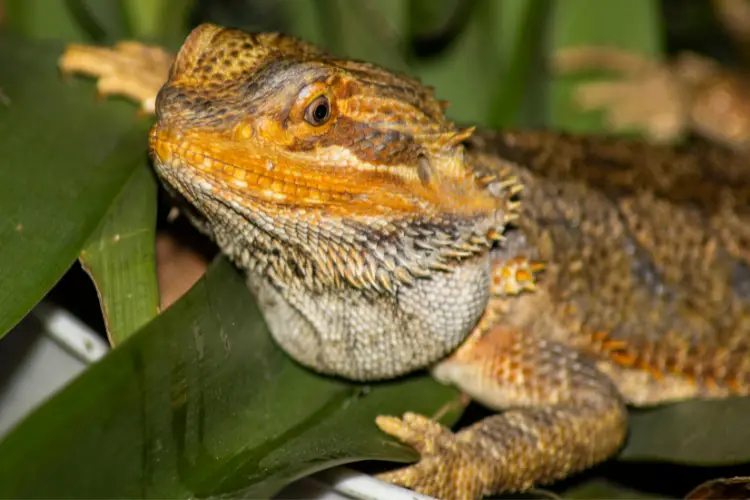
Hatchling Stage
The hatchling stage of bearded dragons starts from birth and lasts for a few months. During this time, they experience rapid growth and are extremely active. Hatchlings are small in size, typically measuring 3 to 4 inches in length.
As they grow, shedding occurs more frequently to accommodate their expanding bodies. It’s essential for hatchlings to have a nutritious diet, mainly consisting of small insects like crickets and finely chopped vegetables, to support their growth and development.
Juvenile Stage
The juvenile stage begins when the bearded dragons measure around 8 inches in length and lasts until they reach 12 to 18 months of age. This stage is characterized by fast-paced growth and a voracious appetite. Juveniles can consume up to 50 crickets every day and require a constant supply of fresh vegetables.
During this phase, shedding continues to occur regularly, and their bodies develop further. By the end of the juvenile stage, bearded dragons will grow to about 15 to 18 inches in length, and their weight may range between 300 and 550 grams.
Adult Stage
Adult bearded dragons have reached sexual maturity and their maximum size, which usually happens between 12 and 18 months of age. Fully grown bearded dragons measure anywhere from 16 to 24 inches in length, with their tails often being as long, if not longer, than their bodies. Their weight typically ranges from 380 to 510 grams.
During the adult stage, growth slows down significantly, and shedding occurs less frequently. Brumation, a period of dormancy similar to hibernation for cold-blooded species, is observed in adult bearded dragons. While they still require a balanced diet, the proportion of insects to vegetables should be adjusted to maintain optimal health.
It’s important to closely monitor the health and well-being of bearded dragons throughout their life stages, ensuring proper nutrition, temperature, and humidity within their enclosure. By doing so, you will help them thrive and reach their full potential in size and lifespan.
Tips for Choosing a Healthy Bearded Dragon

When selecting a bearded dragon as a pet, it’s essential to find a healthy and thriving lizard. Here are a few guidelines that can help you make the right choice.
- Observe physical appearance: A healthy bearded dragon will exhibit bright, clear eyes and a well-rounded body. Their skin should be free of any spots, sores, or discoloration. The lizard’s tail and limbs should also be intact and free of deformities.
- Check for alertness: A healthy bearded dragon should be alert and responsive to its surroundings. If the lizard appears sluggish or unresponsive, it could indicate health issues or poor care.
- Watch their movement: Bearded dragons should move with ease and display good coordination. Any signs of difficulty in movement or limping could indicate illness or injury.
- Assess the environment: The reptile’s living conditions can provide valuable information about its overall health. Ensure that the lizard’s enclosure is clean, well-maintained, and appropriate in size for its age and growth.
- Examine their diet: A well-balanced diet is crucial for a healthy bearded dragon. Ask the seller or breeder about the lizard’s diet and ensure it’s receiving proper nutrients from a mix of insects and vegetables.
- Inquire about the lizard’s age: Bearded dragons attain maturity and their full size around 18 months old. Knowing the age of the lizard you’re considering will help you prepare for its growth and understand its specific care requirements.
- Ask for a health history: Request any available records of veterinary care and health history for the bearded dragon. This information will help you maintain a proper care regimen and monitor its health moving forward.
Choosing a healthy bearded dragon is crucial for ensuring the well-being of your new pet and nurturing a long-lasting bond. Follow these guidelines and consult with a knowledgeable reptile specialist to make the best decision for both you and your future lizard companion.
Bearded Dragons as Pets
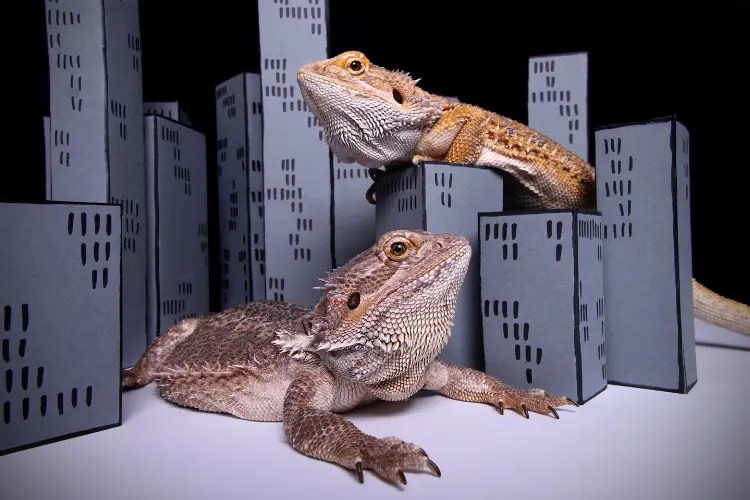
Popular Pet Reptiles
Bearded dragons have become increasingly popular as pets due to their gentle temperament and relatively easy care requirements. These lizards are native to Australia and can grow up to 16 to 24 inches in length. They are well-suited for beginner reptile enthusiasts as well as experienced hobbyists.
Behavior Patterns
These reptiles get their name from the spines that encircle their necks, which they can puff out when they feel threatened or want to display dominance. Bearded dragons typically have a calm and docile demeanor and they are known for being able to build a rapport with their human caretakers. They can be handled gently and enjoy basking in warm light, which is necessary for their health and well-being.
Husbandry
Caring for a bearded dragon involves providing them with a suitable environment, proper nutrition, and attention to their health needs:
- Housing: An adult bearded dragon requires a spacious terrarium, preferably a 40-gallon tank or larger. It’s important to maintain a temperature gradient within their enclosure, with a basking area of around 100°F, and a cooler area around 75-85°F.
- Lighting: Bearded dragons need access to UVB lighting, which helps them synthesize vitamin D3 and metabolize calcium. Keep a UVB bulb on for 10-12 hours per day and replace it every six months to ensure it remains effective.
- Diet: Bearded dragons are omnivores and require a balanced diet of both insects (such as crickets and mealworms) and vegetables (like collard greens, dandelion greens, and bell peppers). A calcium and multivitamin supplement is also necessary for optimal health.
- Health: Regular check-ups with a reptile veterinarian can detect any potential health issues early on, such as metabolic bone disease, parasites, or respiratory infections. Keep their enclosure clean and monitor their behavior for any signs of stress or illness.
By taking the time to understand and cater to their specific husbandry needs, bearded dragons can make wonderful pets for those interested in having a friendly and engaging reptile companion.
FAQs: How Big Do Bearded Dragons Get

Q: How big do male bearded dragons grow?
A: Male bearded dragons can reach a size of 1 to 2 feet in length when fully grown.
Q: What is the size of baby bearded dragons?
A: Baby bearded dragons typically measure around 4 to 7 inches in length when they hatch.
Q: At what age do bearded dragons stop growing?
A: Most bearded dragons stop growing and reach their full size by the time they are 2 to 4 years old.
Q: How big do adult bearded dragons get?
A: Adult bearded dragons can grow up to 2 to 2.5 feet in length, with males generally being larger than females.
Q: What factors influence the growth of bearded dragons?
A: The growth of bearded dragons is influenced by various factors, including genetics, diet, environmental conditions, and overall health.

